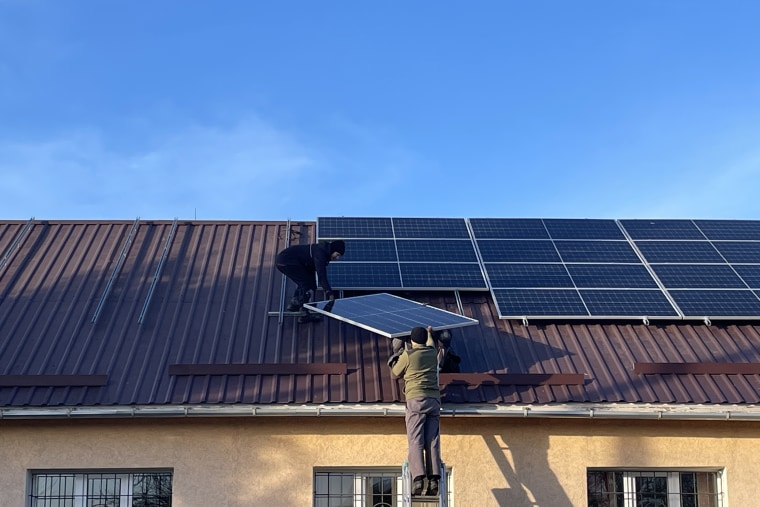The hospital that serves the small village of Horenka, just outside Kyiv, has dealt with many challenges since Russia’s invasion began — including a missile strike, followed by power outages and rolling blackouts affecting medical care for several months.
That changed in the first week of February when the hospital turned on its new solar panel system. It now runs reliably on renewable energy and a heat pump, an eco-friendly alternative to traditional heating methods.
As Russia’s assault continues, several nonprofits in Ukraine are working to fill energy gaps — caused either by attacks on the energy grid or broader energy shortages — with renewable infrastructure. The invasion may also have accelerated the renewable energy transition not only in Ukraine, but also across the European Union.
It can be difficult to inspire Ukrainians, many of whom are living in active war zones, to prioritize sustainability, said Kateryna Bystrytska, a Kyiv-based communication officer at Greenpeace in Central and Eastern Europe, which led the green reconstruction project in Horenka.
“People just want to go home. But many groups are working to show that we can invest in long-term, more efficient technologies before the war ends,” she said. “We don’t need to rebuild old Soviet systems. We need to find the best solutions and advocate for bringing those solutions to Ukraine now.”
Groups like Greenpeace CEE view sustainability as an avenue to improving energy security and meeting climate ambitions that better Ukraine’s viability for a spot in the E.U.
In Zviahel, a city almost 140 miles from Horenka, another hospital received a 32.4-kilowatt solar power plant. The project was funded by an online donation campaign and local investments collected by Ecoclub, an environmental nongovernmental organization located in Rivne.
Ecoclub is already fundraising to install more solar power plants across Ukraine. Ecoaction, a Kyiv-based nonprofit group, is fielding applicants from 40-50 Ukrainian municipalities looking to install solar power plants in their towns, according to Kostiantyn Krynytskyi, the head of the energy department at Ecoaction.
These small projects are proving crucial for some areas. Over the last few months, Russia has continued its targeted attacks on Ukrainian electrical facilities in order to destabilize its energy grid, according to Denys Tsutsaiev, a Kyiv-based campaigner at Greenpeace CEE, and a recent report by the U.S. Energy Department.
Last week, Greenpeace released a map highlighting the environmental damage caused by Russian attacks on infrastructure. Among the disasters are several instances of shelling on power plants, missile strikes on oil depots and major damage to water supply.
Energy security goes beyond just keeping the lights on. Water shortages are a major byproduct of power outages, particularly in rural areas. In Voznesensk, a town in southern Ukraine, Ecoclub established a solar plant at a municipal water utility, said Andriy Martynyuk, executive director of Ecoclub.
Solar panels can pump water whenever they’re operating at full capacity, ensuring a steady supply of water for Voznesensk residents, he said.
Most of Ukraine’s prewar energy came from gas, coal and nuclear power — and most of it still does, but recent Russian attacks on energy infrastructure and power outages have led the government to issue electricity rations.
Energy security is a major benefit of renewable energy for Ukrainians, Martynyuk said. One of the most crucial features of renewables is that they are available even with damaged regional energy infrastructure, he said.
The move toward decentralized, smaller renewable energy units that are harder to target in missile attacks has gained momentum in Ukraine, Krynytskyi said. Now is the time to plan, he added.
“We’re trying to pave the road for the future, which will be a massive reconstruction project,” he said. “From a communication perspective, it’s not just about climate change, it’s not even just about economics now. It’s about energy security and the resilience of communities among people and households.”
As Ukraine plans for its future energy infrastructure, others beyond its borders are reconsidering theirs. A recent analysis found that last year, wind and solar power generated 22% of all electricity in the E.U., overtaking gas (20%) for the first time, and remaining above coal (16%).
“Ukraine can be a reminder that unfortunately, our sources of oil and natural gas are often from geopolitically unstable or unpalatable countries,” said Conor Savoy, senior fellow with the Project on Prosperity and Development at the Center for Strategic and International Studies. “To me, this drives home that energy dependency on a country like Russia can have serious geopolitical consequences, and we should be looking at alternate sources of energy.”
